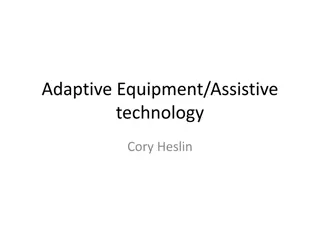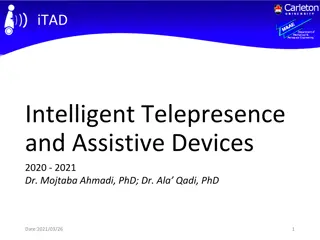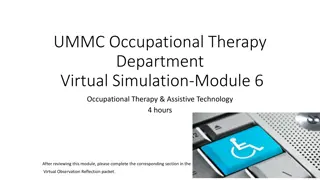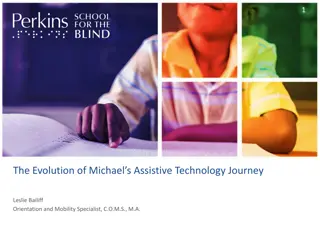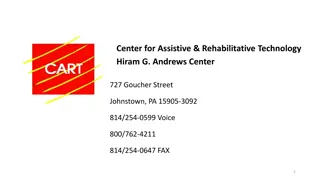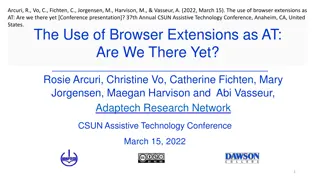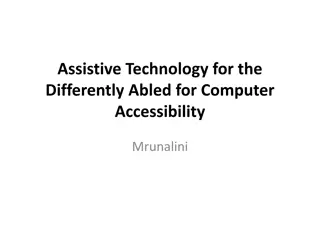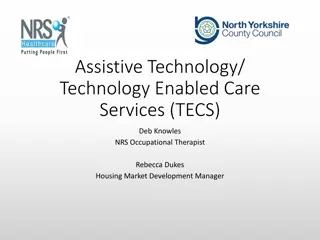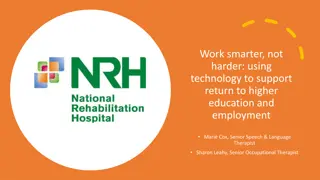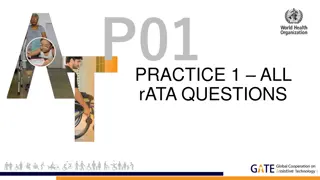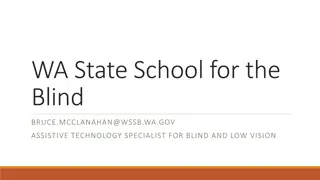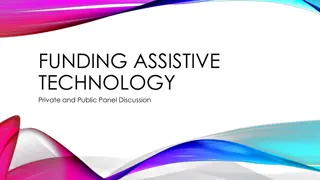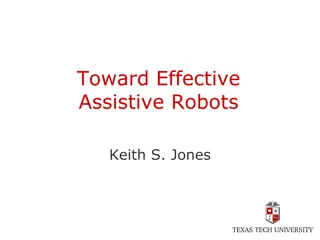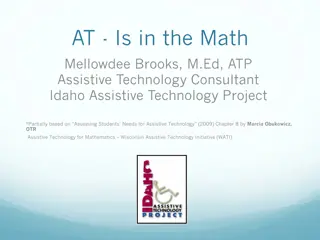Enhancing Lives with Assistive Technology
Assistive Technology empowers individuals with disabilities by providing tools and solutions for mobility, communication, and daily tasks. This technology, defined as items or systems that improve functional capabilities, helps redefine disability, increase resilience, and enable individuals to engage in valued activities. Various forms of Assistive Technology, such as wheeled mobility, specialized seating, computer access, communication aids, and home modifications, play a vital role in enhancing quality of life. By focusing on individual needs and goals, Assistive Technology ensures the best support and facilitates a new model for disability that emphasizes resilience and adaptation.
Download Presentation

Please find below an Image/Link to download the presentation.
The content on the website is provided AS IS for your information and personal use only. It may not be sold, licensed, or shared on other websites without obtaining consent from the author.If you encounter any issues during the download, it is possible that the publisher has removed the file from their server.
You are allowed to download the files provided on this website for personal or commercial use, subject to the condition that they are used lawfully. All files are the property of their respective owners.
The content on the website is provided AS IS for your information and personal use only. It may not be sold, licensed, or shared on other websites without obtaining consent from the author.
E N D
Presentation Transcript
Assistive Technology Using the power of technology for mobility, computer use, communication & control of the environment
Assistive Technology (AT) Goals of this presentation: Help you see ways that AT can help you adapt to life with a spinal cord injury or spinal cord disease Discuss how technology helps to re-define Disability and helps to create resilience Show how AT can enable performance of daily activities and help individuals return to their valued human occupations
What is Assistive Technology? Definition: any item, piece of equipment, or product system, whether acquired commercially off the shelf, modified, or customized, that is used to increase, maintain, or improve functional capabilities of a person with a disability Recognized in Federal Legislation in 1988 with the Technology-Related Assistance Act designed to increase public awareness put a Tech Act resource in every state for providing information and referral to resources
Assistive Technology Wheeled Mobility & Specialized Seating Adaptive Computer Access Electronic Aids to Daily Living Alternative and Augmentative Communication (AAC) Home & Workplace Modifications Vehicle modifications & Adapted driving
Assistive Technology Amazing gear and gadgets! But, what is the key? The match between you and technology! We evaluate with the focus on you & your goals Where you live, what you do, & what is in your future Determine the best control methods Identify the technology that will make a difference and help you make informed decisions Help with set up, fit, and training in how to use it.
A New Model for Disability Think of trying to walk on a trampoline The more severe the impairment, the deeper a body sinks into the trampoline When the surface of the mat is stiffer and more resilient it provides better support Assistive Technology can add this resilience Modify the tools or the task to enable doing. Make needed changes in the lived environment Add human assistance when needed
Dealing with Your Disability Right now: You are using active rehab to improve the strength and ability of your body and learn new skills Active rehab: Enhance unaffected parts and stimulate neural plasticity Teach adaptive strategies & adaptive equipment Prevent secondary disability Modify environments Learn about community supports Assistive Technology
Goals for Assistive Technology Compensate for functional deficits Using a keyboard or speech to write Improve task performance Work faster or with fewer errors Increase control over daily life activities Resume roles: worker, student, volunteer, family member, community member, recreator. Improve quality of life & capacity as an occupational being.
AT: Designing Specialized Seating Assess yours seated posture Look at issues of: Pressure management Postural support Comfort Maximize your ability to use your upper extremities well Prevent pressure ulcers and over-use injuries Prevent spinal deformity and postural collapse
AT: Customizing Ultralight Manual Wheelchairs Allow independent mobility Maximize ability to self propel An effective tool for: Mobility in accessible settings, Access to social & recreational activities A tool for resuming lifestyle; maintaining health & wellness
AT: Choosing the Features of Powered Wheelchairs Allow independent mobility Using specialized controls to bypass any motor limitation An effective tool for: Preventing pressure wounds Moving & managing posture Changing posture for various activities Communicating & socializing Controlling the environment
AT: Powered Wheelchairs and Power Add-Ons Maximize access to environments & activities Focus on activities & roles instead of getting there. Prevent over use injuries and enable improved pressure management/comfort But do require accessible environments
Adaptive Computer Access Mainstream commercial products are very useful and can help you get started with using a computer again Kensington Trackball Speech Recognition
AT: Adaptive Computer Access Enables using a computer for: Shopping & Banking Finding community resources Communicating & Sharing ideas Learning & Education Employment Dating Surfing, games, blogging, etc.
AT: Adaptive Computer Access Computers can be adapted for any impairment: Motor weakness In-coordination Low vision Learning disability Combinations of these limiters Write, journal, visit on Skype, shop, manage money and pay bills, search for resources on most anything, etc. Enable work or education
Adaptive Computer Access Alternate keyboards & mice Speech Recognition (tell the computer what to do or write) Enlarges and reads text Text-to-speech (speaks the words on a screen) Optical Character Recognition (OCR)
Electronic Aids for Daily Living For controlling things in your environment: Telephone Opening and closing doors Home entertainment Lights, fans, heat, & air- conditioning Computer or application based or stand-alone Can be simple or complex
Electronic Aids for Daily Living Uses home automation technology to enable: Staying safely in your own environment Being able to entertain yourself or pursue your interests without having to ask for help Maximizes your independence in your home or work environment. More and more commonplace due to Wi-Fi and internet devices
Electronic Aids for Daily Living iPads, iPhones, iTouch and other Wi-Fi devices can send infrared and/or bluetooth signals and so can the controls of some power wheelchairs so you can operate those devices with your power wheelchair controller
Augmentative Communication Devices Allows independent communication of needs Range in sophistication from: Simple communication of needs/wants Highly developed language that allows saying anything!
Augmentative Communication Devices or Speech Generating Devices Enables: Having your communication heard by others Making choices Directing attendant care Communication with others who are not familiar communication partners
Augmentative Communication Devices or Speech Generating Devices
Benefits of Assistive Technology Our sense of ourselves is wrapped up in what we do! AT enables: Greater control over and participation in the events of everyday life Community living Competitive and supported employment Getting involved in leisure activities
How Do You Get AT? Get referred for an assistive technology (AT) evaluation for Instrumental Activities of Daily Living Rehab facilities have therapists trained to assist Funding and resources can come from: Health insurance or the VA Healthcare Medicare or Medicaid Office of Vocational Rehabilitation for return to work The Tech Act Projects The Kentucky Assistive Technology Services Network INData: The Indiana Assistive Technology Act at Easter Seals Crossroads
Assistive Technology People with disabilities are increasingly a powerful presence in America, from our schools to our businesses to the halls of government --but maybe equally important, increasingly a welcome, comfortable, normal presence. President Roosevelt said, No country, no matter how rich, can afford to waste its human resources! President Bill Clinton, 1999
We now live an Age of Information Technology Use the Internet to learn more about AT Search for Assistive Technology and Spinal Cord Injury Use plain language searches like Spinal Cord Injury and Using a Smartphone Christopher and Dana Reeve Foundation National Spinal Cord Injury Association FacingDisability.org How To and training videos on YouTube orAT product websites and services Call the Tech Act Project in your state




